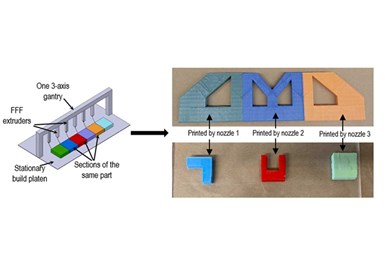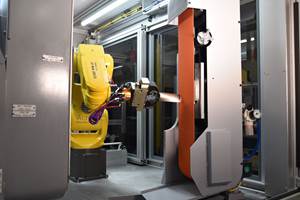Rutgers Engineers Create Faster, More Precise 3D Printing Process
Researchers says their Multiplexed Fused Filament Fabrication Process could be a game changer for the 3D printing industry.
By programming a prototype to move in efficient patterns and by using a series of small nozzles to deposit molten material, researchers say they were able to increase printing resolution and size as well as significantly decrease printing time. Photo Credit: Rutgers School of Engineering
Rutgers engineers says they have created a way to 3D print large, complex parts at a fraction of the cost of current methods.
“We have more tests to run to understand the strength and geometric potential of the parts we can make, but as long as those elements are there, we believe this could be a game changer for the industry,” says Jeremy Cleeman, a graduate student researcher at the Rutgers School of Engineering and the lead author of the study.
The approach is called Multiplexed Fused Filament Fabrication (MF3), which uses a single gantry (the sliding structure on a 3D printer) to print individual or multiple parts simultaneously. By programming a prototype to move in efficient patterns and by using a series of small nozzles — rather than a single large nozzle, as is common in conventional printing — to deposit molten material, the researchers say they were able to increase printing resolution and size as well as significantly decrease printing time.
“MF3 will change how thermoplastic printing is done,” Cleeman says.
According to the researchers, the 3D-printing industry has struggled with what is known as the throughput resolution tradeoff — the speed at which 3D printers deposit material versus the resolution of the finished product. It is said larger diameter nozzles are faster than smaller ones but may generate more ridges and contours that must be smoothed out later, adding significant postproduction costs.
By contrast, smaller nozzles deposit material with greater resolution, but researchers say current methods with conventional software are too slow to be cost effective.
At the heart of MF3’s innovation is its software. To program a 3D printer, engineers use a software tool called a slicer — computer code that maps an object into the virtual “slices” or layers that will be printed. Rutgers researchers wrote slicer software they say optimized the gantry arm’s movement and determined when the nozzles should be turned on and off to achieve the highest efficiency. MF3’s toolpath strategy makes it possible to “concurrently print multiple, geometrically distinct, noncontiguous parts of varying sizes” using a single printer, the researchers wrote in their study.
Cleeman said he sees numerous benefits to this technology. For one, the hardware used in MF3 can be purchased off the shelf and doesn’t need to be customized, making potential adoption easier.
Additionally, because the nozzles can be turned on and off independently, an MF3 printer has built-in resiliency, making it less prone to costly downtime, Cleeman adds. For instance, when a nozzle fails in a conventional printer, the printing process must be halted. In MF3 printing, the work of a malfunctioning nozzle can be assumed by another nozzle on the same arm.
As 3D printing increases in popularity — for manufacturing and particularly for the prototyping of new products — resolving the throughput resolution trade-off is essential, Cleeman says, adding that MF3 is a major contribution to this effort.
Related Content
Implicit Modeling for Additive Manufacturing
Some software tools now use this modeling strategy as opposed to explicit methods of representing geometry. Here’s how it works, and why it matters for additive manufacturing.
Read MoreAircraft Engine MRO: How Additive Manufacturing Plus Robotic Finishing Will Expand Capacity for Blade Repair
AM offers the chance to bring fast, automated processing to individualized, part-by-part restoration of turbomachinery. A cell developed by Acme Manufacturing and Optomec is able to automatically repair 85,000 unique aircraft engine blades per year.
Read MoreThe World’s Tallest Freestanding 3D Printed Structure
Dimensional Innovations paired additive and subtractive manufacturing to create a monument for the NFL’s Las Vegas Raiders new stadium. The “never been done before” project resulted in the world’s tallest freestanding 3D printed structure.
Read MoreCopper, New Metal Printing Processes, Upgrades Based on Software and More from Formnext 2023: AM Radio #46
Formnext 2023 showed that additive manufacturing may be maturing, but it is certainly not stagnant. In this episode, we dive into observations around technology enhancements, new processes and materials, robots, sustainability and more trends from the show.
Read MoreRead Next
Looking to Secure the Supply Chain for Castings? Don't Overlook 3D Printed Sand Cores and Molds
Concerns about casting lead times and costs have many OEMs looking to 3D print parts directly in metal. But don’t overlook the advantages of 3D printed sand cores and molds applied for conventional metal casting, says Humtown leader.
Read MoreTo Improve Performance of Compression Molded Composites, Add 3D Printed Preforms
9T Labs' Additive Fusion Technology enables the manufacture of composite structures with as much or as little reinforcement as is necessary, using 3D printed continuous fiber preforms to add strength just where needed.
Read MoreGE Additive Rebrands as Colibrium Additive
As part of the brand name transition, both the Concept Laser and Arcam EBM legacy brands will be retired.
Read More













.png;maxWidth=300;quality=90)










